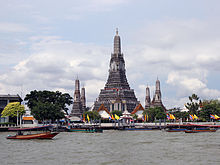Wat Arun
| Wat Arun Ratchawararam Ratchawaramahawihan | |
|---|---|
 |
|
| Basic information | |
| Geographic coordinates | 13°44′37″N 100°29′20″E / 13.74361°N 100.48889°ECoordinates: 13°44′37″N 100°29′20″E / 13.74361°N 100.48889°E |
| Affiliation | Theravada Buddhism |
| Country | Thailand |
| Website | www |
| Completed | before 1656 BE |
Wat Arun Ratchawararam Ratchawaramahawihan (Thai: วัดอรุณราชวรารามราชวรมหาวิหาร) or Wat Arun (Thai pronunciation: [wát ʔarun], "Temple of Dawn") is a Buddhist temple (wat) in Bangkok Yai district of Bangkok, Thailand, on the Thonburi west bank of the Chao Phraya River. The temple derives its name from the Hindu god Aruna, often personified as the radiations of the rising sun. Wat Arun is among the best known of Thailand's landmarks and the first light of the morning reflects off the surface of the temple with pearly iridescence. Although the temple had existed since at least the seventeenth century, its distinctive prang (spires) were built in the early nineteenth century during the reign of King Rama II.
A Buddhist temple had existed at the site of Wat Arun since the time of the Ayutthaya Kingdom. It was then known as Wat Makok, after the village of Bang Makok in which it was situated. (Makok is the Thai name for the Spondias pinnata plant) According to the historian Prince Damrong Rajanubhab, the temple was shown in French maps during the reign of King Narai (1656–1688). The temple was renamed Wat Chaeng by King Taksin when he established his new capital of Thonburi near the temple, following the fall of Ayutthaya. It is believed that Taksin vowed to restore the temple after passing it at dawn. The temple enshrined the Emerald Buddha image before it was transferred to Wat Phra Kaew on the river's eastern bank in 1785. The temple was located in grounds of the royal palace during Taksin's reign, before his successor, Rama I, moved the palace to the other side of the river. It was abandoned, for a long period of time, until Rama II, who restored the temple and extended the pagoda to 70m.
...
Wikipedia

